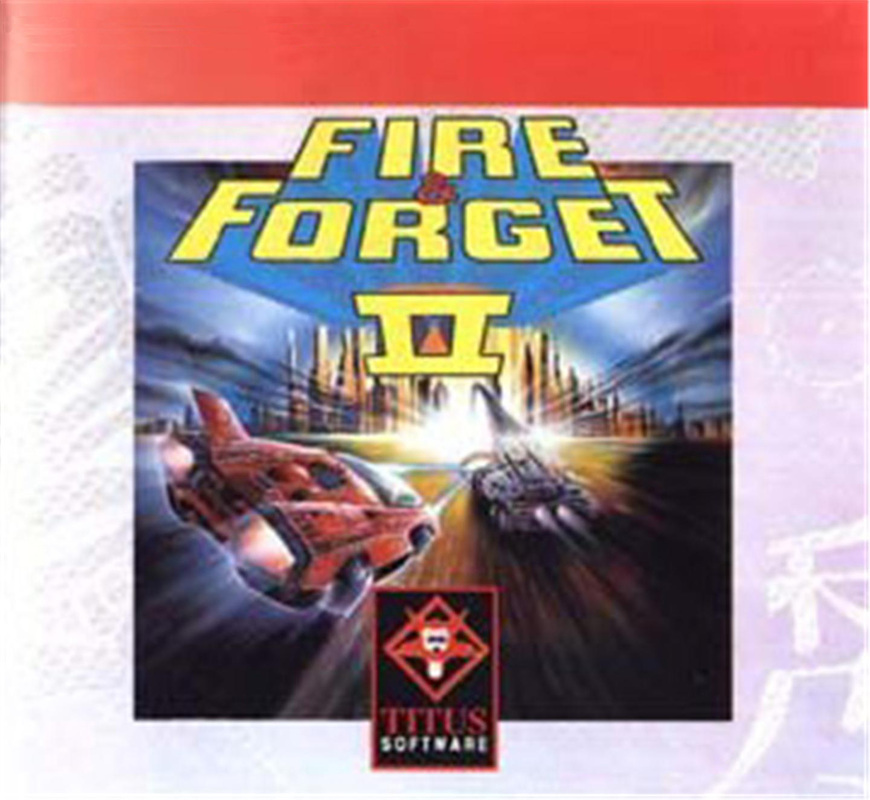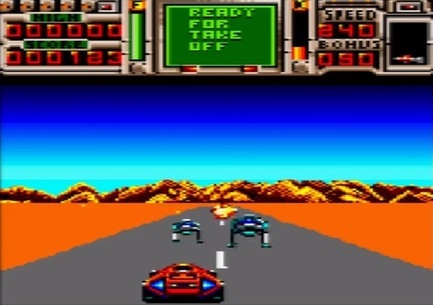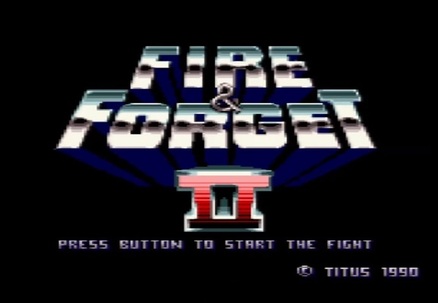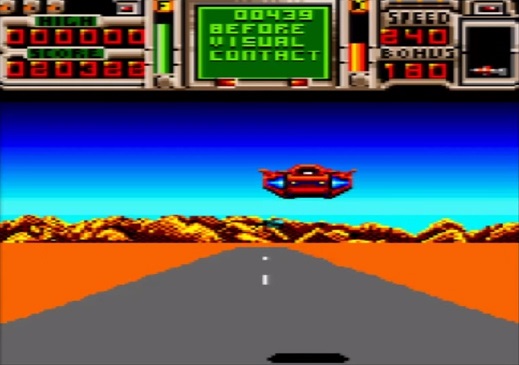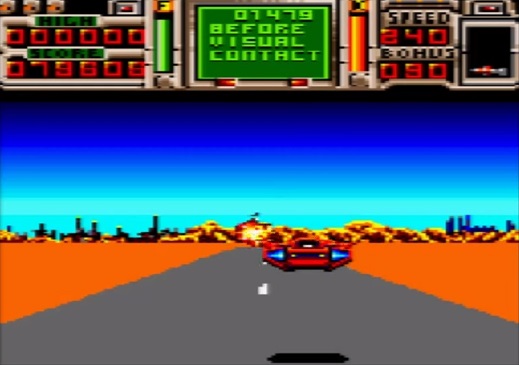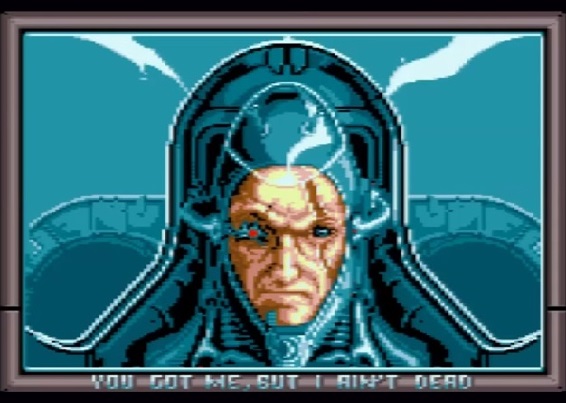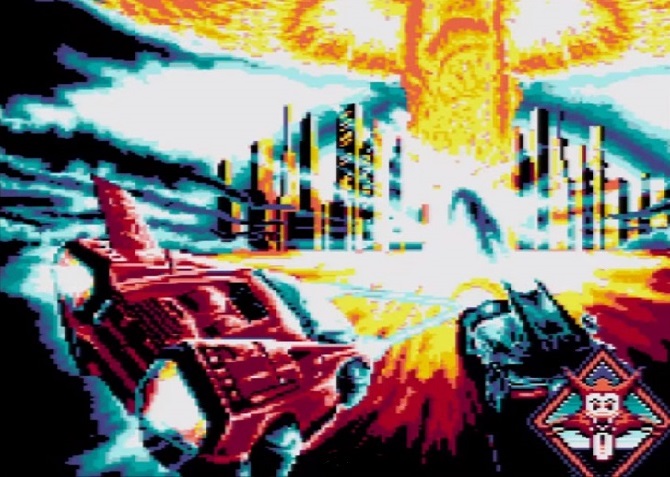FIRE & FORGET II (GX4000)
The late eighties saw a slew of road racing games that went the extra mile and added a little spice to the proceedings; namely wanton violence and masses of collateral damage. The original Fire & Forget was a clear rip-off of 1987’s Atari semi-classic Roadblasters, just with a lot of the speed and fun removed. Its sequel popped up a year later with a substantial change; you now have a flying car that shoots missiles, looks like an armoured Lamborghini and travels at faster than 200kpm. This idea alone would certainly have had 80's schoolboys drooling at the thought of a hybrid DeLorean/Mask vehicle, so with that in mind it was produced as an early title for the GX4000. Graphically and phonically it pleases, but this may be a textbook case of being a tad devoid of lasting appeal under the pomp, but is it really that forgettable?
Sometimes given the sub-title The Death Convoy, Fire & Forget II puts you in command of the awesome sounding Thundermaster II. Part supercar, part assault aircraft, part tank, it’s every teenagers dream automobile. A terrorist cell is planning to bomb the city of Megalopolis and it’s down to you to stop the convoy reaching the city. Standing between you and this goal are many, and I mean MANY enemy vehicles, dangerous aircraft, static turrets and large bosses to destroy within the life limit. This all sounds terrific fun, but it’s implemented with a degree of looseness and misplanning. First off, the driving aspect of the game has been predominantly negated due to the fact that you don’t even need to steer your Thundermaster II around corners, as it just follows the road dead centre automatically if you leave the controls alone. You move sideways solely to aim and fire at your quarry, so the feeling of speed is removed to a degree as you only have to concentrate on your targeting talents. This does give a sense of disappointment and a reduction of skill, as any realism is not present. Shooting the enemies is a struggle however, especially in the later stages so there is plenty to be getting on with without the distraction of actually navigating the road.
Sometimes given the sub-title The Death Convoy, Fire & Forget II puts you in command of the awesome sounding Thundermaster II. Part supercar, part assault aircraft, part tank, it’s every teenagers dream automobile. A terrorist cell is planning to bomb the city of Megalopolis and it’s down to you to stop the convoy reaching the city. Standing between you and this goal are many, and I mean MANY enemy vehicles, dangerous aircraft, static turrets and large bosses to destroy within the life limit. This all sounds terrific fun, but it’s implemented with a degree of looseness and misplanning. First off, the driving aspect of the game has been predominantly negated due to the fact that you don’t even need to steer your Thundermaster II around corners, as it just follows the road dead centre automatically if you leave the controls alone. You move sideways solely to aim and fire at your quarry, so the feeling of speed is removed to a degree as you only have to concentrate on your targeting talents. This does give a sense of disappointment and a reduction of skill, as any realism is not present. Shooting the enemies is a struggle however, especially in the later stages so there is plenty to be getting on with without the distraction of actually navigating the road.
The problem with this singular gameplay trait unfortunately is that it becomes repetitive very quickly, even with the vast repertoire of foes and pleasing tricky points to conquer. The graphics kind of support and detract from this simultaneously in the matter. The backgrounds and sprites are well done, with a bright variance of colours and a very cool looking Lamborghini-esque Thundermaster II, the car itself looks and handles great in flying mode in particular, but the surrounding environment is sparse and devoid of features. Endless, dull roads don’t help the nature of continuous shooting and dodging of oncoming crafts with their somewhat jerky scaling. You get the feeling that with a little more care, it would play smoother, feel faster, have more to grab the attention and be an experience to savour. The elements are there for something nifty, but the potential has not been delivered. Still, the handling is not all bad, and the HUD is clear and detailed.
Despite its shortcomings, Fire & Forget II does have highlights that make it a short but enjoyable undertaking. The management of road fuel versus flight fuel is something to take into consideration, the flight dynamics are nicely done with inverted controls and a strict landing code. Try to land without deploying the wheels and an explosion is inevitable. You also have missiles at your disposal and an abundance of re-fills en route to collect. It’s true to say the flying car aspect is the most exciting part of the game, as you have to carefully choose when and when not to take to the skies. Boss vehicles can be challenging for the most, and after a stage is complete you are rewarded with a very lovely looking transition still image. This can be said also for the title screen, which is a beautifully drawn eight bit representation of the cover art.
Despite its shortcomings, Fire & Forget II does have highlights that make it a short but enjoyable undertaking. The management of road fuel versus flight fuel is something to take into consideration, the flight dynamics are nicely done with inverted controls and a strict landing code. Try to land without deploying the wheels and an explosion is inevitable. You also have missiles at your disposal and an abundance of re-fills en route to collect. It’s true to say the flying car aspect is the most exciting part of the game, as you have to carefully choose when and when not to take to the skies. Boss vehicles can be challenging for the most, and after a stage is complete you are rewarded with a very lovely looking transition still image. This can be said also for the title screen, which is a beautifully drawn eight bit representation of the cover art.
Titus was known for a divergent musical style in many of its games, and the tunes are another fine and praise-worthy characteristic of the game. There are tons of different BGM on each level, all distinctive from each other, and a fine title screen ditty. Effects are passable too, with some cool explosions, bleeps and weapon sounds. This supports the game well, meaning the overall presentation is of a high quality, separating it from a CPC title with similar attributes.
Saving the city of Megalopolis is something of a double-edged sword. Visually, it isn’t groundbreaking but does perform rather nicely, and I can’t have any major complaints about the audio support either. On the whole it’s not the mediocre game many reviewers make it out to be, but lacking that final touch of sparkle that would bring a flying, guns-blazing Mad Max chic to life on the GX4000. Some may argue this is a fairly forgettable title, but my stance is that it’s a playable driving blaster with a few blank shots that bring it down to the just above average. Fire while it still brings satisfaction; forget when the tedium gets too much.
Saving the city of Megalopolis is something of a double-edged sword. Visually, it isn’t groundbreaking but does perform rather nicely, and I can’t have any major complaints about the audio support either. On the whole it’s not the mediocre game many reviewers make it out to be, but lacking that final touch of sparkle that would bring a flying, guns-blazing Mad Max chic to life on the GX4000. Some may argue this is a fairly forgettable title, but my stance is that it’s a playable driving blaster with a few blank shots that bring it down to the just above average. Fire while it still brings satisfaction; forget when the tedium gets too much.
|
|
VERDICT
Visual: 8/10
Audio: 8/10 Gameplay: 6/10 Longevity: 5/10 OVERALL: 7/10 |
